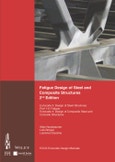Table of Contents
Foreword xi
Preface xiii
Acknowledgments xv
Symbology xvii
Terminology xxi
Chapter 1
Introduction 1
1.1 Basis of fatigue design in steel structures 1
1.1.1 General 1
1.1.2 Main parameters influencing fatigue life 3
1.1.3 Expression of fatigue strength 7
1.1.4 Variable amplitude and cycle counting 10
1.1.5 Damage accumulation 13
1.2 Damage equivalent factor concept 15
1.3 Codes of Practice 18
1.3.1 Introduction 18
1.3.2 Eurocodes 3 and 4 18
1.3.3 Eurocode 9 21
1.3.4 Execution (EN 1090-2) 23
1.3.5 Other execution standards 29
1.4 Description of the structures used in the worked examples 30
1.4.1 Introduction 30
1.4.2 Steel and concrete composite road bridge (worked example 1) 31
1.4.3 Chimney (worked example 2) 34
1.4.4 Crane supporting structures (worked example 3) 39
Chapter 2
Application Range and Limitations 43
2.1 Introduction 43
2.2 Materials 44
2.3 Corrosion 44
2.4 Temperature 45
2.5 Loading rate 47
2.6 Limiting stress ranges 47
Chapter 3
Determination of Stresses And Stress Ranges 51
3.1 Fatigue loads 51
3.1.1 Introduction 51
3.1.2 Road bridges 52
3.1.3 Railway bridges 57
3.1.4 Crane supporting structures 59
3.1.5 Masts, towers, and chimneys 61
3.1.6 Silos and tanks 70
3.1.7 Tensile cable structures, tension components 70
3.1.8 Other structures 71
3.2 Damage equivalent factors 72
3.2.1 Concept 72
3.2.2 Critical influence line length 75
3.2.3 Road bridges 76
3.2.4 Railway bridges 82
3.2.5 Crane supporting structures 84
3.2.6 Towers, masts and chimneys 92
3.3 Calculation of stresses 93
3.3.1 Introduction 93
3.3.2 Relevant nominal stresses 94
3.3.3 Stresses in bolted joints 96
3.3.4 Stresses in welds 96
3.3.5 Nominal stresses in steel and concrete composite bridges 99
3.3.6 Nominal stresses in tubular structures (frames and trusses) 100
3.4 Modified nominal stresses and concentration factors 104
3.4.1 Generalities 104
3.4.2 Misalignments 107
3.5 Geometric stresses (Structural stress at the hot spot) 113
3.5.1 Introduction 113
3.5.2 Determination using FEM modelling 115
3.5.3 Determination using formulas 117
3.6 Stresses in orthotropic decks 119
3.7 Calculation of stress ranges 122
3.7.1 Introduction 122
3.7.2 Stress range in non-welded details 123
3.7.3 Stress ranges in bolted joints 125
3.7.4 Stress range in welds 131
3.7.5 Multiaxial stress range cases 133
3.7.6 Stress ranges in steel and concrete composite structures 137
3.7.7 Stress ranges in connection devices from steel and concrete composite structures 142
3.8 Modified Nominal stress ranges 146
3.9 Geometric stress ranges 148
Chapter 4
Fatigue Strength 157
4.1 Introduction 157
4.1.1 Set of fatigue strength curves 157
4.1.2 Modified fatigue strength curves 162
4.1.3 Size effects on fatigue strength 163
4.1.4 Mean stress influence 165
4.1.5 Post-weld improvements 165
4.2 Fatigue detail tables 166
4.2.1 Introduction 166
4.2.2 Non-welded details classification (EN 1993-1-9, Table 8.1) 166
4.2.3 Welded plated details classification (general comments) 168
4.2.4 Longitudinal welds, (built-up sections, EN1993-1-9 Table 8.2), including longitudinal butt welds 169
4.2.5 Transverse butt welds (EN1993-1-9 Table 8.3) 170
4.2.6 Welded attachments and stiffeners (EN 1993-1-9 Table 8.4), and load-carrying welded joints (EN 1993-1-9 Table 8.5) 171
4.2.7 Welded tubular details classification (EN 1993-1-9 Tables 8.6 and 8.7) 174
4.2.8 Orthotropic deck details classification (EN 1993-1-9 Tables 8.8 and 8.9) 175
4.2.9 Crane girder details (EN 1993-1-9 Table 8.10) 176
4.2.10 Tension components details (EN 1993-1-11) 176
4.2.11 Geometric stress categories (EN 1993-1-9, Annex B, Table B.1) 179
4.2.12 Particular case of web breathing, plate slenderness limitations 180
4.3 Determination of fatigue strength or life by testing 180
Chapter 5
Reliability and Verification 183
5.1 Generalities 183
5.2 Strategies 185
5.2.1 Safe life 185
5.2.2 Damage tolerant 185
5.3 Partial factors 186
5.3.1 Introduction 186
5.3.2 Action effects partial factor 187
5.3.3 Strength partial factor 188
5.4 Verification 192
5.4.1 Introduction 192
5.4.2 Verification using the fatigue limit 193
5.4.3 Verification using damage equivalent factors 201
5.4.4 Verification using damage accumulation method 207
5.4.5 Verification of tension components 209
5.4.6 Verification using damage accumulation in case of two or more cranes 210
5.4.7 Verification under multiaxial stress ranges 212
Chapter 6
Brittle Fracture 221
6.1 Introduction 221
6.2 Steel quality 223
6.3 Relationship between different fracture toughness test results 224
6.4 Fracture concept in EN 1993-1-10 229
6.4.1 Method for toughness verification 229
6.4.2 Method for safety verification 231
6.4.3 Flaw size design value 234
6.4.4 Design value of the action effect stresses 236
6.5 Standardisation of choice of material: maximum allowable thicknesses 238
References 247
Annex A Standards for steel construction 257
Annex B Fatigue detail tables with commentary 263
B.1 Plain members and mechanically fastened joints (EN 1993-1-9, Table 8.1) 264
B.2 Welded built-up sections (EN 1993-1-9, Table 8.2) 267
B.3 Transverse butt welds (EN 1993-1-9, Table 8.3) 269
B.4 Attachments and stiffeners (EN 1993-1-9, Table 8.4) 272
B.5 Load carrying welded joints (EN 1993-1-9, Table 8.5) 274
B.6 Hollow sections (T ≤ 12.5 mm) (EN 1993-1-9, Table 8.6) 277
B.7 Lattice girder node joints (EN 1993-1-9, Table 8.7) 279
B.8 Orthotropic decks - closed stringers (EN 1993-1-9, Table 8.8) 281
B.9 Orthotropic decks - open stringers (EN 1993-1-9, Table 8.9) 283
B.10 Top flange to web junction of runway beams (EN 1993-1-9, Table 8.10) 284
B.11 Detail categories for use with geometric (hot spot) stress method (EN 1993-1-9, Table B1) 286
B.12 Tension components 288
B.13 Review of orthotropic decks details and structural analysis 290
Annex C Maximum Permissible Thicknesses Tables 295
C.1 Maximum permissible values of element thickness t in mm (EN 1993-1-10, Table 2.1) 295
C.2 Maximum permissible values of element thickness t in mm (EN 1993-1-12, Table 4) 296








